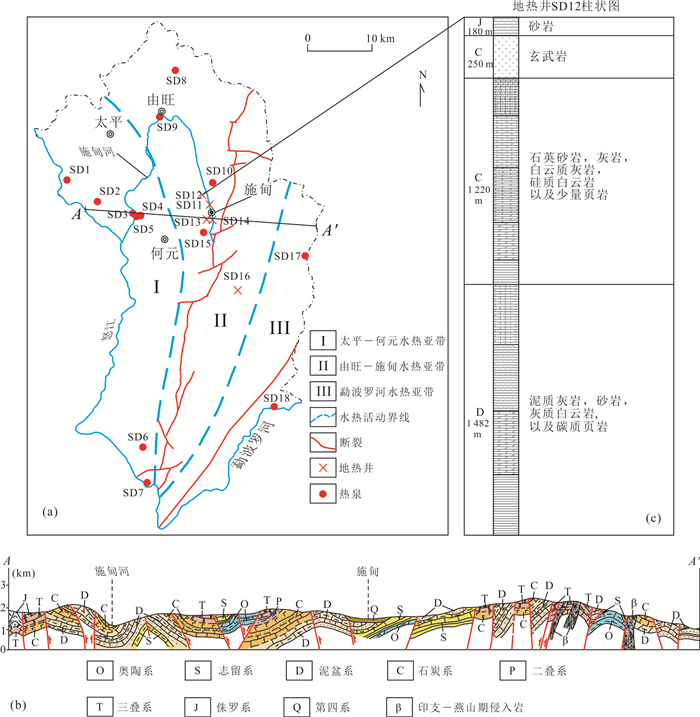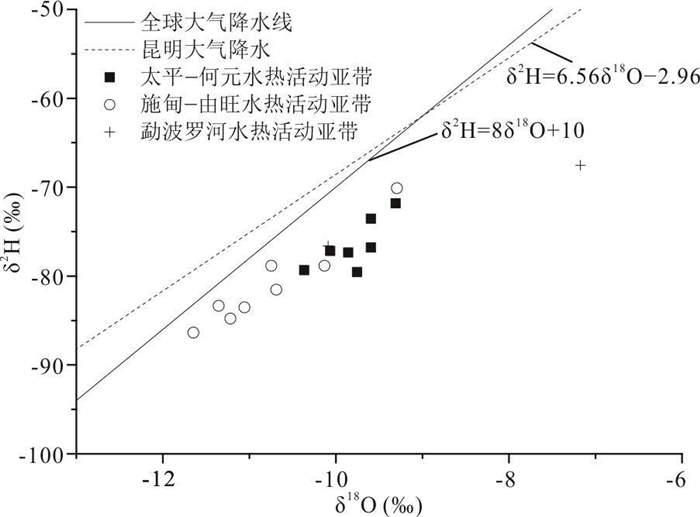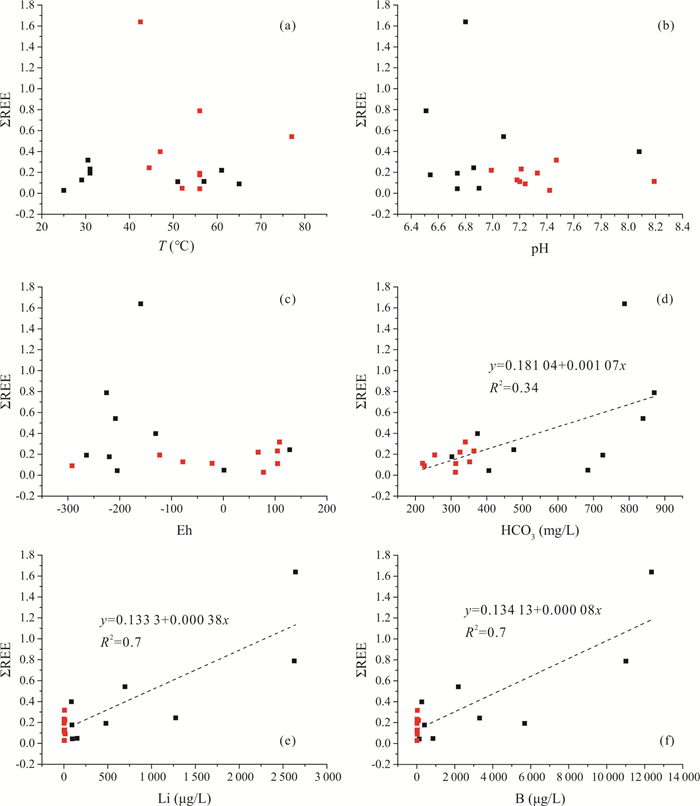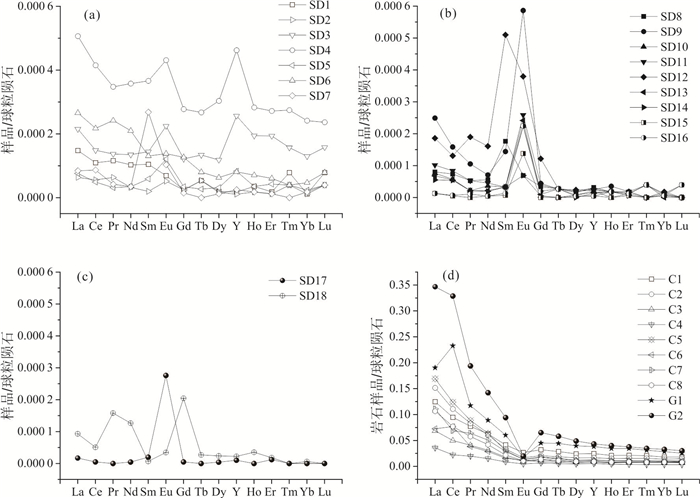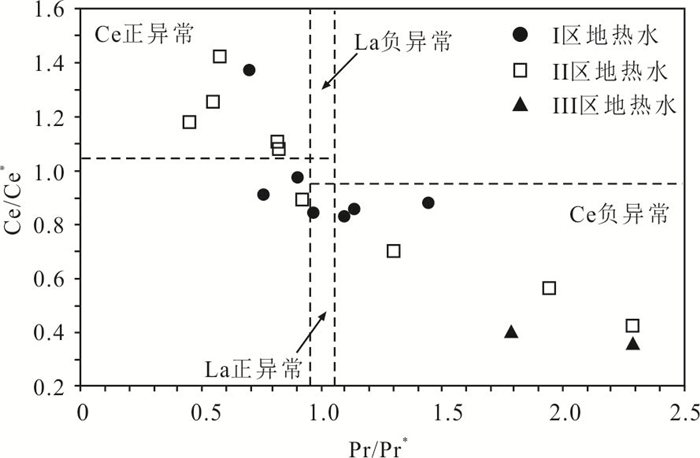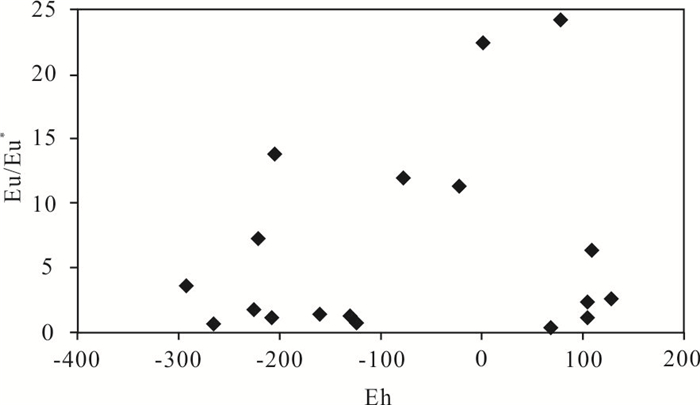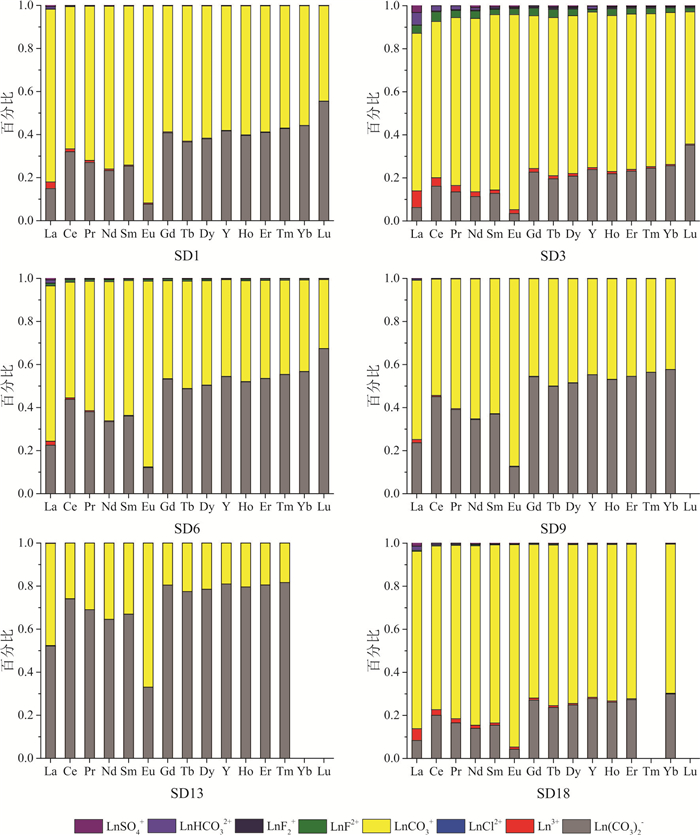Geochemical Behavior and Indicative Effect of REEs in Carbonate Geothermal Reservoir: A Case of Shidian Geothermal System
-
摘要: 施甸中‒低温地热系统是滇‒藏‒川地热带的重要组成部分,强烈的构造运动使该地热系统热储结构复杂,当前对其地热水地球化学过程研究程度很低.通过分析施甸地热水中稀土元素(REEs)的地球化学行为,本文旨在揭示碳酸盐岩热储内的主导性水文地球化学过程.结果表明,施甸地热水大部分富集LREEs,显示其对围岩REEs特征的继承.地热水也表现出Ce、Eu和Y异常,其中Ce负异常因继承碳酸盐岩Ce负异常或保留地热水古氧化环境特征而形成,Eu正异常源于地热水对长石类矿物的溶解,Y正异常则是地热水运移过程中其中的Ho受碳酸盐矿物优先吸附造成.PHREEQC计算表明施甸地热水中REEs的主要形态为LnCO3+和Ln(CO3)2‒,在同一水样中,LnCO3+含量随原子系数增加依次递减,而Ln(CO3)2-则依次递增.此外,地热水中还存在少量Ln3+、LnF2+、LnHCO32+和LnSO4+,其含量均随原子系数增加依次减小,受地热水pH和F-、HCO3-、SO42-含量共同控制.REEs分析可为地热水地球化学过程研究提供重要证据.Abstract: Shidian medium-low temperature geothermal system, which has a complicated reservoir structure due to the intense tectonic movement, is a critical part of the Yunnan–Sichuan-Tibet geothermal Province (YST) with few studies focusing on it. The goal of this research is to study the geochemical behavior of the rare earth elements (REEs) in the Shidian geothermal system in order to reveal the dominant hydrogeochemical processes in the carbonate geothermal reservoir. The results in this study show that most of the geothermal fluids are rich in LREEs, indicating an inheritance of REEs feature from the host rocks. The geothermal fluids also have Cerium (Ce), Europium (Eu) and Yttrium (Y) anomalies. Among which, the negative Ce anomalies are probably the result of interaction between geothermal water and carbonate rock or an indicator of paleo-oxic conditions. The positive Eu anomalies are ascribed to the dissolution of feldspar minerals, while the positive Y anomalies are caused by the preferential adsorption of Ho on carbonates during the transport of geothermal fluids. The calculation by PHREEQC shows that the dominant species of REEs in geothermal fluid are LnCO3+ and Ln(CO3)2‒. The content of LnCO3+ decreases with the increasing atomic number, in contrast, Ln(CO3)2‒ increases with the increasing atomic number. In addition, there are still some Ln3+, LnF2+, LnHCO32+ and LnSO4+ species with small amount in the geothermal fluid, which are controlled by the pH of water as well as F‒, HCO3‒, and SO42‒ content. REEs can provide important evidence for studying the hydrogeochemical processes in a geothermal system.
-
Key words:
- REEs /
- carbonate rock /
- water-rock interaction /
- Shidian geothermal system /
- geochemistry
-
图 1 滇‒藏‒川地热带(a)、保山地块(b)以及施甸(c)简要地质构造图(据禹丽等,2014)
Fig. 1. Geotectonic locations of the Baoshan block in the Yunnan-Sichuan-Tibet geothermal belt (a and b) and geological structures in Shidian (c) (after Yu et al., 2014)
表 1 施甸地热水样现场物理化学指标、化学组分含量以及氢氧同位素特征
Table 1. Physical parameters and concentrations of chemical constituents in Shidian water samples
编号 T(℃) Eh pH K Ca Na Mg CO3 HCO3 F Cl NO3 SO4 Si Li B Mn Fe δ18O(‰) δ2H(‰) 水化学类型 SD1 31 105 7.21 1.13 99.24 3.09 42.81 0.36 364 0.21 5.03 18.79 14.14 6.72 3.45 17.19 0.21 0.00 -9.60 -73.54 Ca·Mg-HCO3 SD2 51 105 7.20 2.00 83.99 2.94 29.49 0.29 313 0.25 2.95 1.85 9.77 12.30 4.82 22.96 0.10 1.71 -9.86 -77.35 Ca·Mg-HCO3 SD3 56 -226 6.51 42.45 210.67 145.96 45.73 0.19 870 2.47 13.86 3.03 54.53 23.93 2 628.01 11 008.53 76.19 15.72 -9.76 -79.54 Ca·Na-HCO3 SD4 43 -160 6.80 44.23 233.74 152.74 59.26 0.34 787 2.05 14.54 4.82 35.87 23.06 2 642.07 12 352.62 172.35 32.80 -9.60 -76.77 Ca·Na·Mg-HCO3 SD5 45 128 6.86 22.19 125.81 66.69 32.28 0.22 476 1.86 8.89 2.22 60.28 17.53 1 274.95 3 308.42 0.15 4.66 -10.07 -77.17 Ca·Na·Mg-HCO3 SD6 77 -208 7.08 10.07 25.55 365.39 5.14 0.65 839 3.15 4.40 0.71 33.32 52.84 696.01 2 186.92 67.73 0.00 -10.37 -79.33 Na-HCO3 SD7 56 -264 6.74 15.68 39.53 275.37 15.95 0.25 726 3.15 6.36 0.21 39.11 26.58 479.00 5 674.88 84.57 0.00 -9.31 -71.80 Na-HCO3 SD8 31 -123 7.33 1.38 90.82 1.72 16.74 0.31 254 0.15 3.27 3.10 9.82 8.37 3.59 11.41 7.04 13.59 -11.22 -84.78 Ca·Mg-HCO3 SD9 31 108 7.47 3.32 93.47 4.87 25.77 0.59 340 0.37 3.55 0.84 7.48 10.80 7.89 29.77 2.26 0.21 -10.13 -78.84 Ca·Mg-HCO3 SD10 29 -78 7.18 4.22 136.15 4.50 18.91 0.32 352 0.20 5.72 4.38 7.22 7.75 3.32 20.73 0.70 14.66 -9.29 -70.11 Ca·Mg-HCO3 SD11 56 -220 6.54 28.90 92.88 51.95 10.26 0.06 302 1.30 10.00 0.38 6.50 46.00 92.83 408.42 282.77 19 180.07 -11.35 -83.35 Ca·Na-HCO3 SD12 47 -131 8.08 11.13 54.02 95.48 16.42 2.65 374 1.07 3.26 0.33 11.02 14.77 85.26 262.04 13.69 37.77 -11.65 -86.36 Ca·Na-HCO3 SD13 57 -22 8.19 2.72 64.07 5.89 25.02 1.94 220 0.21 2.86 0.24 11.81 14.42 8.43 18.99 57.60 5.06 -11.06 -83.53 Ca·Mg-HCO3 SD14 65 -292 7.24 4.20 69.24 5.71 20.49 0.22 225 0.30 2.68 0.26 11.63 18.06 14.85 24.24 56.76 91.78 -10.75 -78.83 Ca·Mg-HCO3 SD15 25 78 7.42 1.70 91.41 5.11 23.59 0.48 312 0.24 3.97 2.06 12.58 7.25 4.75 11.85 5.56 1.11 -10.69 -81.51 Ca·Mg-HCO3 SD16 52 -205 7.73 4.92 42.72 260.62 2.22 0.24 406 0.82 3.48 0.31 200.56 30.96 96.62 126.26 128.56 1 927.80 -11.20 -84.82 Na-HCO3·SO4 SD17 52 1 6.90 11.47 96.50 225.58 18.27 0.35 684 1.10 4.65 0.36 24.94 24.10 151.30 852.86 43.43 0.00 -7.18 -67.54 Na·Ca-HCO3 SD18 61 67 6.99 2.42 89.60 10.60 27.62 0.19 325 0.38 2.83 1.04 19.30 19.54 11.05 88.46 0.94 27.96 -10.09 -76.61 Ca·Mg-HCO3 注:Li、B、Sr、Mn和Fe单位是μg/L,其余化学组分单位是mg/L. 表 2 施甸地热水稀土元素含量分布特征(单位:μg/L)
Table 2. REEs concentrations of geothermal fluids in Shidian geothermal system (μg/L)
编号 La Ce Pr Nd Sm Eu Gd Tb Dy Y Ho Er Tm Yb Lu ΣREE Pr/Pr* Ce/Ce* Eu/Eu* Y/Ho SD1 0.035 0.067 0.011 0.048 0.016 0.004 0.005 0.002 0.005 0.028 0.002 0.003 0.002 0.002 0.002 0.232 1.091 0.831 1.070 0.505 SD2 0.015 0.034 0.006 0.015 0.003 0.003 0.005 0.002 0.004 0.017 0.001 0.002 0.001 0.002 0.001 0.111 1.441 0.879 2.354 0.613 SD3 0.051 0.091 0.013 0.063 0.022 0.013 0.025 0.005 0.03 0.402 0.011 0.032 0.004 0.022 0.004 0.788 0.965 0.845 1.689 1.317 SD4 0.12 0.254 0.033 0.167 0.056 0.025 0.057 0.01 0.077 0.726 0.016 0.045 0.007 0.041 0.006 1.64 0.899 0.972 1.340 1.636 SD5 0.018 0.03 0.003 0.016 0.009 0.007 0.007 0.001 0.008 0.13 0.002 0.007 0.001 0.004 0.001 0.244 0.758 0.912 2.599 2.343 SD6 0.063 0.133 0.023 0.098 0.02 0.008 0.026 0.003 0.016 0.127 0.004 0.01 0.001 0.008 0.002 0.542 1.134 0.856 1.072 1.145 SD7 0.02 0.053 0.004 0.016 0.041 0.006 0.003 0 0.003 0.039 0.001 0.002 0 0.003 0.001 0.192 0.697 1.369 0.732 1.406 SD8 0.019 0.045 0.005 0.026 0.027 0.004 0.007 0.001 0.004 0.049 0.001 0.002 0.001 0.002 0.001 0.194 0.815 1.107 0.655 1.766 SD9 0.059 0.097 0.01 0.033 0.022 0.034 0.009 0.001 0.005 0.039 0.002 0.003 0.001 0.002 0 0.317 0.919 0.895 6.250 0.703 SD10 0.018 0.035 0.002 0.017 0.005 0.013 0.001 0 0.002 0.032 0 0.002 0 0.001 0 0.128 0.450 1.179 11.939 - SD11 0.024 0.051 0.005 0.021 0.005 0.015 0.008 0.001 0.005 0.036 0.001 0.003 0 0.002 0 0.177 0.820 1.083 7.223 1.298 SD12 0.044 0.08 0.018 0.075 0.078 0.022 0.025 0.001 0.006 0.042 0.001 0.003 0 0.003 0 0.398 1.301 0.697 1.201 1.514 SD13 0.016 0.034 0.002 0.01 0.005 0.014 0.002 0.001 0.002 0.024 0.001 0.002 0.001 0 0 0.114 0.547 1.255 11.383 0.865 SD14 0.013 0.033 0.002 0.009 0.005 0.004 0.001 0 0 0.02 0.001 0.001 0 0.001 0 0.09 0.575 1.421 3.674 0.721 SD15 0.003 0.003 0.001 0.002 0.001 0.008 0.001 0 0.001 0.008 0 0.001 0 0.001 0 0.029 2.292 0.423 24.194 - SD16 0.003 0.004 0.001 0.002 0.002 0.013 0.004 0.001 0.001 0.007 0.001 0.002 0.001 0.001 0.001 0.044 1.946 0.564 13.778 0.252 SD17 0.004 0.003 0.001 0.002 0.003 0.016 0.001 0 0.001 0.016 0 0.002 0 0 0 0.049 2.292 0.358 22.543 - SD18 0.022 0.031 0.015 0.059 0.001 0.002 0.042 0.001 0.006 0.035 0.002 0.003 0 0.001 0 0.22 1.784 0.404 0.327 0.631 表 3 施甸岩石样品REEs含量分布特征(10-6)
Table 3. REEs concentrations of rock samples in Shidian geothermal system (10-6)
编号 岩性 La Ce Pr Nd Sm Eu Gd Tb Dy Y Ho Er Tm Yb Lu Ce/Ce* Y/Ho C1 碳酸盐岩 29.550 57.861 7.342 29.151 6.351 1.549 6.586 1.066 6.118 38.540 1.201 3.524 0.524 3.080 0.461 0.936 1.065 C2 35.876 67.789 7.887 28.442 5.106 0.967 4.235 0.690 4.144 26.262 0.844 2.573 0.393 2.354 0.375 0.982 1.153 C3 16.273 30.551 3.870 14.504 2.746 0.571 2.547 0.402 2.224 15.368 0.439 1.318 0.189 1.225 0.186 0.797 1.161 C4 8.428 13.678 1.863 7.057 1.337 0.280 1.337 0.198 1.196 8.523 0.240 0.642 0.086 0.558 0.086 0.945 1.044 C5 40.063 75.740 8.439 29.709 4.650 0.773 3.560 0.533 2.977 18.279 0.631 1.862 0.288 1.856 0.282 0.989 1.059 C6 17.219 47.067 3.646 13.308 2.398 0.674 1.881 0.307 1.758 11.829 0.389 1.314 0.221 1.518 0.246 0.990 1.097 C7 26.290 42.118 6.065 23.666 4.400 0.788 3.642 0.583 3.009 19.391 0.615 1.778 0.257 1.515 0.217 0.788 1.137 C8 25.250 47.187 5.466 19.550 3.337 0.624 2.778 0.420 2.415 14.376 0.470 1.436 0.205 1.350 0.198 0.940 1.102 G1 花岗岩 45.099 142.420 11.146 41.569 9.202 1.015 9.256 1.659 10.034 59.914 1.951 5.700 0.797 4.809 0.649 1.513 1.107 G2 82.165 201.172 18.424 66.359 14.418 1.157 13.367 2.173 12.429 68.023 2.267 6.252 0.882 5.565 0.769 1.216 1.082 球粒陨石a 0.237 0.612 0.095 0.467 0.153 0.058 0.205 5 0.037 4 0.254 1.570 0.056 6 0.165 5 0.025 5 0.170 0.025 4 注:a. 数据来源于李义曼等(2022). -
Ahanger, M. A., Jeelani, G., 2022. Deformation Kinematics of Main Central Thrust Zone (MCTZ) in the Western Himalayas. Journal of Earth Science, 33(2): 452-461. https://doi.org/10.1007/s12583-020-1059-6 Bai, D. H., Unsworth, M. J., Meju, M. A., et al., 2010. Crustal Deformation of the Eastern Tibetan Plateau Revealed by Magnetotelluric Imaging. Nature Geoscience, 3(5): 358-362. https://doi.org/10.1038/ngeo830 Chen, S., Gui, H. R., Sun, L. H., et al., 2011. Rare Earth Element Fractionation between Groundwater and Wall Rock in Limestone Aquifer: Sample from Taiyuan Formation Limestone Aquifer in Renlou Coal Mine, Northern Anhui Province. Geoscience, 25(4): 802-807 (in Chinese with English abstract). doi: 10.3969/j.issn.1000-8527.2011.04.022 Coleman, M. L., Shepherd, T. J., Durham, J. J., et al., 1982. Reduction of Water with Zinc for Hydrogen Isotope Analysis. Analytical Chemistry, 54(6): 993-995. https://doi.org/10.1021/ac00243a035 Craddock, P. R., Bach, W., Seewald, J. S., et al., 2010. Rare Earth Element Abundances in Hydrothermal Fluids from the Manus Basin, Papua New Guinea: Indicators of Sub-Seafloor Hydrothermal Processes in Back-Arc Basins. Geochimica et Cosmochimica Acta, 74(19): 5494-5513. https://doi.org/10.1016/j.gca.2010.07.003 Craig, H., 1961. Isotopic Variations in Meteoric Waters. Science, 133(3465): 1702-1703. https://doi.org/10.1126/science.133.3465.1702 Epstein, S., Mayeda, T., 1953. Variation of O18 Content of Waters from Natural Sources. Geochimica et Cosmochimica Acta, 4(5): 213-224. https://doi.org/10.1016/0016-7037(53)90051-9 Feng, D., Chen, D. F., Peckmann, J., et al., 2010. Authigenic Carbonates from Methane Seeps of the Northern Congo Fan: Microbial Formation Mechanism. Marine and Petroleum Geology, 27(4): 748-756. https://doi.org/10.1016/j.marpetgeo.2009.08.006 Feng, D., Lin, Z. J., Bian, Y. Y., et al., 2013. Rare Earth Elements of Seep Carbonates: Indication for Redox Variations and Microbiological Processes at Modern Seep Sites. Journal of Asian Earth Sciences, 65: 27-33. https://doi.org/10.1016/j.jseaes.2012.09.002 Goodenough, K. M., Deady, E. A., Beard, C. D., et al., 2021. Carbonatites and Alkaline Igneous Rocks in Post-Collisional Settings: Storehouses of Rare Earth Elements. Journal of Earth Science, 32(6): 1332-1358. https://doi.org/10.1007/s12583-021-1500-5 Hu, H., Wang, J. L., 2015. On Characteristics of Hydrogen and Oxygen Isotope in Precipitation in Yunnan and Analysis of Moisture Sources. Journal of Southwest China Normal University (Natural Science Edition), 40(5): 142-149 (in Chinese with English abstract). Johannesson, K. H., Farnham, I. M., Guo, C. X., et al., 1999. Rare Earth Element Fractionation and Concentration Variations along a Groundwater Flow Path within a Shallow, Basin-Fill Aquifer, Southern Nevada, USA. Geochimica et Cosmochimica Acta, 63(18): 2697-2708. https://doi.org/10.1016/S0016-7037(99)00184-2 Johannesson, K. H., Lyons, W. B., Yelken, M. A., et al., 1996. Geochemistry of the Rare-Earth Elements in Hypersaline and Dilute Acidic Natural Terrestrial Waters: Complexation Behavior and Middle Rare-Earth Element Enrichments. Chemical Geology, 133(1-4): 125-144. https://doi.org/10.1016/S0009-2541(96)00072-1 Klinkhammer, G. P., Elderfield, H., Edmond, J. M., et al., 1994. Geochemical Implications of Rare Earth Element Patterns in Hydrothermal Fluids from Mid-Ocean Ridges. Geochimica et Cosmochimica Acta, 58(23): 5105-5113. https://doi.org/10.1016/0016-7037(94)90297-6 Koeppenkastrop, D., De Carlo, E. H., 1993. Uptake of Rare Earth Elements from Solution by Metal Oxides. Environmental Science & Technology, 27(9): 1796-1802. https://doi.org/10.1021/es00046a006 Li, Y. M., Chen, K., Tian, J., et al., 2022. REE Characteristics and Their Influencing Factors of the Geothermal Water in Tangkeng Geothermal Field, Fengshun, Guangdong Province. Geological Review, 68(3): 993-1005 (in Chinese with English abstract). Liu, M. L., He, T., Wu, Q. F., et al., 2020. Hydrogeochemistry of Geothermal Waters from Xiongan New Area and Its. Earth Science, 45(6): 2221-2231 (in Chinese with English abstract). Ma, L., Liu, Q., He, H. J., et al., 2021. Geochemistry of Rare Earth Elements in the Groundwater of Dagu River Basin. Journal of Marine Sciences, 39(2): 33-42 (in Chinese with English abstract). doi: 10.3969/j.issn.1001-909X.2021.02.004 Mathurin, F. A., Åström, M. E., Drake, H., et al., 2014. REE and Y in Groundwater in the Upper 1.2 km of Proterozoic Granitoids (Eastern Sweden)-Assessing the Role of Composition and Origin of Groundwaters, Geochemistry of Fractures, and Organic/Inorganic Aqueous Complexation. Geochimica et Cosmochimica Acta, 144: 342-378. https://doi.org/10.1016/j.gca.2014.08.004 Molnar, P., Lyon-Caent, H., 1989. Fault Plane Solutions of Earthquakes and Active Tectonics of the Tibetan Plateau and Its Margins. Geophysical Journal International, 99(1): 123-154. https://doi.org/10.1111/j.1365-246x.1989.tb02020.x Munemoto, T., Ohmori, K., Iwatsuki, T., 2015. Rare Earth Elements (REE) in Deep Groundwater from Granite and Fracture-Filling Calcite in the Tono Area, Central Japan: Prediction of REE Fractionation in Paleo- to Present-Day Groundwater. Chemical Geology, 417: 58-67. https://doi.org/10.1016/j.chemgeo.2015.09.024 Noack, C. W., Dzombak, D. A., Karamalidis, A. K., 2014. Rare Earth Element Distributions and Trends in Natural Waters with a Focus on Groundwater. Environmental Science & Technology, 48(8): 4317-4326. https://doi.org/10.1021/es4053895 Oliveri, Y., Cangemi, M., Capasso, G., et al., 2019. Pathways and Fate of REE in the Shallow Hydrothermal Aquifer of Vulcano Island (Italy). Chemical Geology, 512: 121-129. https://doi.org/10.1016/j.chemgeo.2019.02.037 Parkhurst, D. L., Appelo, C. A. J., 1999. User's Guide to PHREEQC a Computer Program for Speciation, Batch-Reaction, One-Dimensional Transport, and Inverse Geochemical Calculation. U. S. Geological Survey, Reston. Sanada, T., Takamatsu, N., Yoshiike, Y., 2006. Geochemical Interpretation of Long-Term Variations in Rare Earth Element Concentrations in Acidic Hot Spring Waters from the Tamagawa Geothermal Area, Japan. Geothermics, 35(2): 141-155. https://doi.org/10.1016/j.geothermics.2006.02.004 Smedley, P. L., 1991. The Geochemistry of Rare Earth Elements in Groundwater from the Carnmenellis Area, Southwest England. Geochimica et Cosmochimica Acta, 55(10): 2767-2779. https://doi.org/10.1016/0016-7037(91)90443-9 Sverjensky, D. A., 1984. Europium Redox Equilibria in Aqueous Solution. Earth and Planetary Science Letters, 67(1): 70-78. https://doi.org/10.1016/0012-821X(84)90039-6 Tao, C. H., Li, H. M., Huang, W., et al., 2011. Mineralogical and Geochemical Features of Sulfide Chimneys from the 49°39'E Hydrothermal Field on the Southwest Indian Ridge and Their Geological Inferences. Chinese Science Bulletin, 56(26): 2828-2838. https://doi.org/10.1007/s11434-011-4619-4 Taylor, S. R., McLennan, S. M., 1988. Handbook on the Physics and Chemistry of Rare Earths. Elsevier, Amsterdam. Wang, M. M., Zhou, X., Liu, Y., et al., 2020. Major, Trace and Rare Earth Elements Geochemistry of Geothermal Waters from the Rehai High-Temperature Geothermal Field in Tengchong of China. Applied Geochemistry, 119: 104639. https://doi.org/10.1016/j.apgeochem.2020.104639 Wang, Y. T., Li, J. X., Xue, X. B., et al., 2021. Similarities and Differences of Main Controlling Factors of Natural High Iodine Groundwater between North China Plain and Datong Basin. Earth Science, 46(1): 308-320 (in Chinese with English abstract). Wood, S. A., Shannon, W. M., 2003. Rare-Earth Elements in Geothermal Waters from Oregon, Nevada, and California. Journal of Solid State Chemistry, 171(1-2): 246-253. https://doi.org/10.1016/S0022-4596(02)00160-3 Yokoyama, T., Nakai, S., Wakita, H., 1999. Helium and Carbon Isotopic Compositions of Hot Spring Gases in the Tibetan Plateau. Journal of Volcanology and Geothermal Research, 88(1-2): 99-107. https://doi.org/10.1016/S0377-0273(98)00108-5 Yu, L., Li, G. J., Wang, Q. F., et al., 2014. Petrogenesis and Tectonic Significance of the Late Cretaceous Magmatism in the Northern Part of the Baoshan Block: Constraints from Bulk Geochemistry, Zircon U-Pb Geochronology and Hf Isotopic Compositions. Acta Petrologica Sinica, 30(9): 2709-2724 (in Chinese with English abstract). Zhang, J., Nozaki, Y., 1998. Behavior of Rare Earth Elements in Seawater at the Ocean Margin: a Study along the Slopes of the Sagami and Nankai Troughs near Japan. Geochimica et Cosmochimica Acta, 62(8): 1307-1317. https://doi.org/10.1016/S0016-7037(98)00073-8 陈松, 桂和荣, 孙林华, 等, 2011. 灰岩含水层中稀土元素在地下水与围岩间的分异: 以皖北任楼煤矿太原组灰岩含水层为例. 现代地质, 25(4): 802-807. doi: 10.3969/j.issn.1000-8527.2011.04.022 胡菡, 王建力, 2015. 云南地区大气降水中氢氧同位素特征及水汽来源分析. 西南师范大学学报(自然科学版), 40(5): 142-149. https://www.cnki.com.cn/Article/CJFDTOTAL-XNZK201505025.htm 李义曼, 陈凯, 天娇, 等, 2022. 广东丰顺汤坑地热田热水中稀土元素特征及其影响因素. 地质论评, 68(3): 993-1005. https://www.cnki.com.cn/Article/CJFDTOTAL-DZLP202203017.htm 刘明亮, 何曈, 吴启帆, 等, 2020. 雄安新区地热水化学特征及其指示意义. 地球科学, 45(6): 2221-2231. doi: 10.3799/dqkx.2019.270 马莉, 刘茜, 何会军, 等, 2021. 大沽河流域地下水中稀土元素的地球化学特征. 海洋学研究, 39(2): 33-42. doi: 10.3969/j.issn.1001-909X.2021.02.004 王雨婷, 李俊霞, 薛肖斌, 等, 2021. 华北平原与大同盆地原生高碘地下水赋存主控因素的异同. 地球科学, 46(1): 308-320. doi: 10.3799/dqkx.2019.261 禹丽, 李龚健, 王庆飞, 等, 2014. 保山地块北部晚白垩世岩浆岩成因及其构造指示: 全岩地球化学、锆石U-Pb年代学和Hf同位素制约. 岩石学报, 30(9): 2709-2724. https://www.cnki.com.cn/Article/CJFDTOTAL-YSXB201409020.htm -









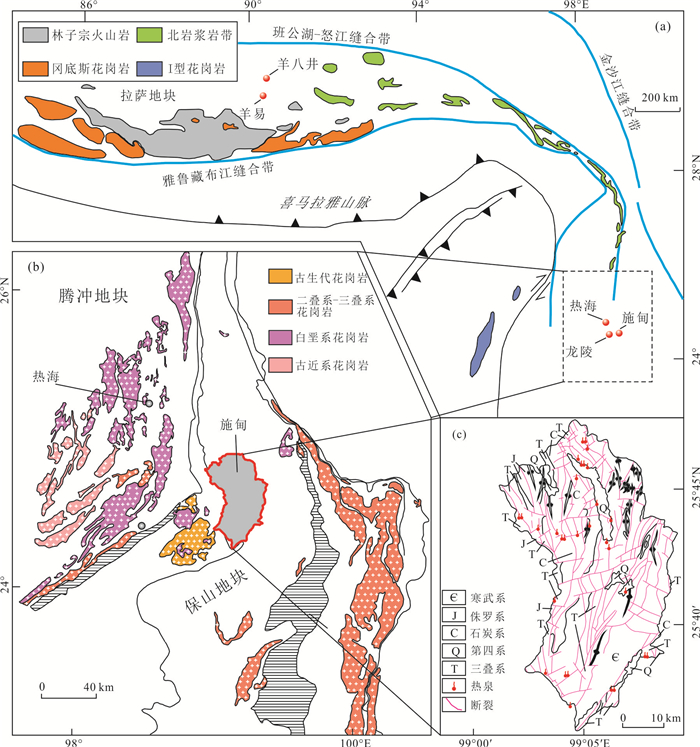
 下载:
下载:
